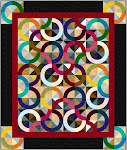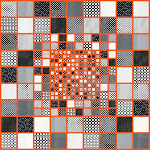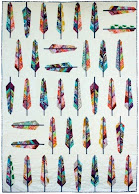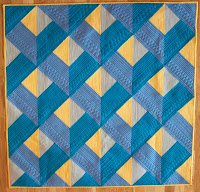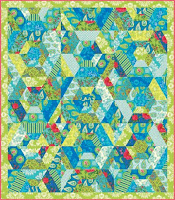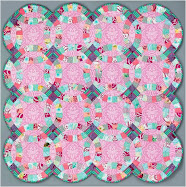Flying geese have been dated by
Barbara Brackman’s Encyclopedia of Pieced Quilt Patterns as having been first published back to 1894, when the Ohio Farmer
featured them on their “woman’s pages.”
Now, 120 years
later—these simple little units are used in all kinds of quilts, from
traditional to modern to improvisational and the most liberated of wonky quilting! (check out my own wonky liberated flying geese at the very bottom of this post!
Here are some fun suggestions and links for making flying geese and using them in your own quilting. The tips and ideas are free and all images are either linked to the book they came from at Martingale, or free usage ones from google and facebook, or belong to me and my own projects.
And shown above: Some of my own projects from my 3D Baby Quilt where 3D flying geese become "interactive" pinwheels, to my free pieced art quilts, to three tote bags and more!
If you're looking for great flying geese ideas..there are so many styles to choose from..and ways to create them. Here are a few fun and creative ways with tips and techniques along the way!

1. Traditional Technique: for quilters who like to use it up and make it do.
2. Flip, Flip, Finish: for quilters who enjoy a good ol’ chain-piecing veg-out.
3. Fast and Furious: for quilters who like to finish fast—times four.
4. Paper-Pieced Geese: for quilters who wish to piece with the utmost precision.
Fly
down to the bottom of this post to see how other quilters use
flying-geese patchwork in their quilts. And then let your own flying-geese
quilts take wing!
Note: instructions will yield 2″ x 4″ flying-geese units (finished).
To
make one flying-geese unit: Cut a 2 7/8″ square of fabric in half
diagonally to yield two small triangles. Cut a 5 1/4″ square of a
contrasting fabric in half diagonally to yield two large triangles,
reserving one for another use. Sew one small triangle to one diagonal
edge of the large triangle; press toward the small triangle. Sew the
second small triangle to the other diagonal edge of the large triangle
to make a flying-geese unit; press toward the small triangle.
Cyndi used her traditionally pieced flying-geese patchwork to make the blue flower points in her quilt “Moonflower.”
Note: instructions will yield 2″ x 4″ flying-geese units (finished).
A
“flippy corner” is a casual way to sew half-square triangles onto
squares or rectangles without actually handling a triangle shape—cheater
triangles, so to speak. This technique can be applied to a number of
commonly used units and blocks. A good example is the flying-geese unit.
Traditionally,
a flying-geese unit calls for one quarter-square triangle and two
half-square triangles. If you prefer, however, you can make flying-geese
units using the flippy-corner technique, as I did for the quilt pattern
“Splash Dance.”
To
make finished-size 2″ x 4″ units, substitute a 2 1/2″ x 4 1/2″
rectangle for the quarter-square triangle and two 2 1/2″ squares for the
two half-square triangles. Make the unit as shown in the following
steps.
1. Draw a diagonal line on the back of each 2 1/2″ square.

2.
With right sides together, align one marked square with one edge of the
2 1/2″ x 4 1/2″ rectangle as shown. Stitch one thread width to the
outside of the diagonal line.
3. Cut 1/4″ beyond the stitching line as shown. Press the resulting triangle open and the seam allowance toward the triangle.
4. Repeat steps 2 and 3 on the other edge of the rectangle to complete the unit.
Here’s the fun “Splash Dance” quilt Cathy made with her patchwork flying geese—she used flying-geese units as frog’s legs!
Note: instructions will yield 2″ x 3 1/2″ flying-geese units (finished).
Here
are the steps for my favorite, no-special-ruler-required method of
making flying-geese units. For each set of four matching flying-geese
units, you’ll need one large square and four matching small squares. The
large square will become the large triangle in each unit and the four
small squares will become the small side triangles in each unit.
Let’s use a 4 1/4″ large square and four 2 3/8″ small squares to try this technique.
1.
On the wrong side of each of the four small squares, draw a diagonal
line from corner to corner using a permanent pen, pencil, or chalk
marker.
2.
With right sides together, place two marked squares on opposite corners
of the large square. The points of the small squares will overlap just a
little bit and the drawn line should extend across the large square
from corner to corner as shown.
3.
Stitch a scant 1/4″ seam allowance on both sides of the drawn lines.
Cut the squares apart on the drawn lines. Press the seam allowances
toward the small triangles.
4.
With right sides together, place one of the remaining marked squares on
the corner of each piece. The drawn line should extend from the point
of the corner to the point between the two small triangles. Stitch a
scant 1/4″ seam allowance on both sides of the drawn line. Cut the
pieces apart on the drawn line. Press the seam allowances toward the
small triangles. You’ll have four flying-geese units. The units will
measure 2″ x 3 1/2″.
Paper-Pieced Geese: The Ultimate in Accuracy
From Karen Costello Soltys, author of Bits and Pieces
As Karen says: "I’ve
always been drawn to patchwork designs that form a diagonal pattern
such as Flying Geese, but piecing many little triangles and setting
triangles can be tedious with traditional cutting and sewing methods. I
turned to foundation piecing to make my “Christmas Goose”
quilt quite manageable. You can’t beat foundation piecing for
accuracy—getting all those little triangles to be perfectly pointy and
match up with those in the next block is a breeze."
Karen used her flying-geese units to make a small Christmas quilt—the perfect size for a table topper or wall quilt:
5. Wonky and Liberated...Make these with NO precision, NO pattern, and totally wild abandon!
Michele Bilyeu blogs
With Heart and Hands as she shares a quilting journey through her life in Salem, Oregon and Douglas, Alaska and all of her
AAQI Quilting. Sharing thousands of links to
Free Quilt and Quilt Block Patterns and encouraging others to join in the
Liberated Quilting Challenge and make or donate small art quilts to the
Alzheimer's Art Quilt Initiative (AAQI) Help us change the world, one little quilt at a time!

